Lesson 2: Main Parts of Horizontal Milling Machines
In this lesson we’re going to be studying two important things:
1) The names and purposes of the MAIN PARTS of a milling.
2) The names and purposes of the CONTROLS of a milling.
NOTE:
We’re also going to be seeing pairs of controls. A pair is something that comes in twos.
e.g., most people have a pair of eyes and a pair of ears.
A pair of controls gives us two ways to do the same thing. Look for pairs of controls in the reading.
MAIN PARTS OF A MILLING MACHINE
| 1.) knee | the part of the mill which moves up and down on the ways.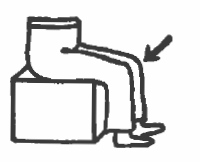 e.g., The knee on a mill looks like the knee on a human being. |
| 2.) column | the tall, straight, vertical part of the milling machine. e.g., The column on a mill is named after the columns we see in buildings. |
| 3.) reservoir | a storage place for liquids. e.g., A city’s supply of water is often stored in a reservoir. |
| 4.) mechanism | the moving parts in a machine that work together for a particular purpose. e.g., The knee of the mill contains a mechanism for raising and lowering. |
| 5.) manual | done by a movement of the hand. e.g., The milling machine has a set of manual controls. Related word: manually. |
| 6.) housing | a protective, outer layer of material which encloses a mechanism of some kind. e.g., There is a housing around the swivel mechanism to protect it from dirt. |
| 7.) capable | able to do something well. e.g., A seven-year-old child is very capable of learning new words in any language. |
| 8.) longitudinal | having to do with the length of something. 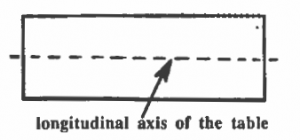 e.g., The longitudinal axis of the table runs through the center of the table from end to end. Related word: longitude. |
| 9.) emergency | a suddenly happening situation that requires immediate action. e.g., Pepe, tum off the mill right away, if there is an emergency. |
| 10.) to engage | to bring two gears together so that me teeth of one drive the teeth of the other. e.g., An engaging lever brings gears together that help automatic operations. |
| 11.) crank | a handle bent at right angles to a shaft, used to transmit motion.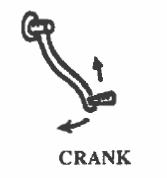 e.g., The vertical motion of the knee can be manually control led by a crank. |
| 12.) alert | aware; seeing and sensing what is happening around you; ready to react. e.g., A good worker is always alert at work. |
| 13.) wandering mind | a mind that is thinking about many other things and not about work. e.g., If your mind wanders during work at the machines, you could lose a finger or a hand. |
Vocabulary Practice
Spelling
THE MAIN PARTS 0F A HORIZONTAL MILLING MACHINE
(Universal Horizontal Knee-and-Column Machine)
The horizontal milling machine that we are studying has four main parts:
(1) There is the overarm which supports the arbor with its cutting tool, the milling cutter;
(2) there is the table which brings the work up and feeds it into the spinning cutters;
(3) there is the knee, which travels up and down and on which the table rests; and
(4) the column with its ways on which the knee travels up and down.
Because it uses the knee and the column as the means by which work is fed into the cutter, the horizontal mill is called a “knee-and-column” milling machine.
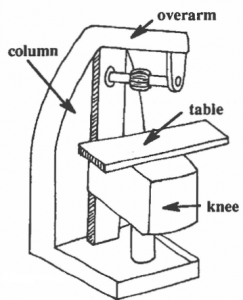
Let us look in more detail at the main parts:
1.) Base: The entire machine rests on a heavy metal base. This base has a dish-shaped top which acts as a reservoir for cutting fluid.
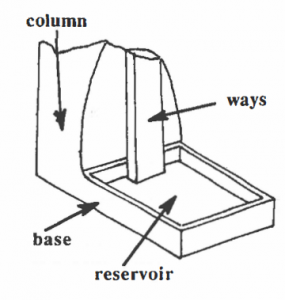
2.) Column and Ways: The column is attached to the base and has ways that are very precisely made to guide the up and down motions of the knee.
3.) Knee: The knee contains the mechanism (moving parts) which control the vertical movements of the knee; there is an automatic mechanism which allows for an automatic feed at a given rate; there is another mechanism which allows the machinist to move the knee up and down manually by the use of a hand crank.
4.) Saddle: The saddle 1s situated on top of the knee and beneath the table; the saddle has controls which allow for the table to be moved in toward the column, or out, away from the column. This motion is called cross feed; it can be done using either manual or automatic controls (which we will soon study).
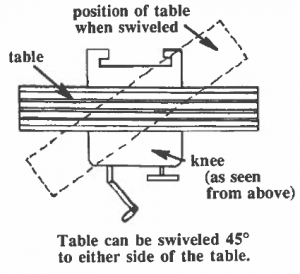
5.) Table Swivel Housing: Some horizontal mills have an added feature, a part located between the saddle and the table called the table swivel housing. This allows the table to be swiveled (turned) at 45° angles to either side, in the table1s horizontal plane. If a horizontal mill has a table swivel housing, it is called a universal horizontal milling machine, because it is capable of more jobs.
6.) Table: The table rests on the saddle’s guideways. The table is very flat and is the part to which the work is securely fastened. There are T-slots that run the entire length of the table. T-bolts can be fitted into these T-slots to help secure the work.
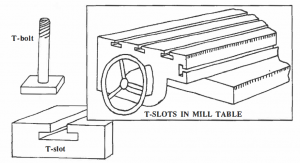
The table can be moved in four different ways:
(1) longitudinal movement (or table feed): The table can be moved in the horizontal plane in the direction of either end of the table. (Side to side)
(2) vertical feed: As we have seen, the table can be moved up or down by the raising or lowering of the knee.
(3) cross feed: As we have seen, the table can be moved in, toward the column, or out, away from the column, by movements, in or out, of the saddle.
(4) swivel movement: As we have seen, the table can be turned up to 45° away from the longitudinal axis of the table in the horizontal plane by turning the table swivel housing.
7.) Spindle: Inside the column is a mechanism which rotates a spindle located near the top of the mill. Into this spindle are inserted accessories, like the arbor, a shaft for support of the cutters. The spindle supplies the rotational power to the arbor and the cutters.
8.) Overarm: Above the spindle, an overarm projects out in a horizontal plane above the table and the work. Its job is to hold one or more arbor supports.
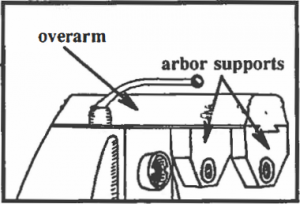
9.) Arbor supports: One or more arbor supports can be attached and clamped in place anywhere along the overarm. As their name indicates, their purpose is to hold, support, and align the arbor and whatever cutters are on it.
Matching Definitions
Parts Identification
Fill in the Blanks
The Main Parts of a Milling Machine
Spelling
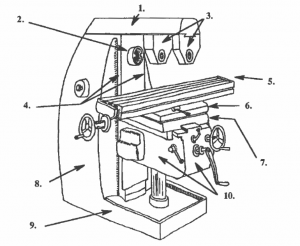
Identifying Parts


